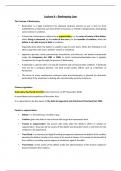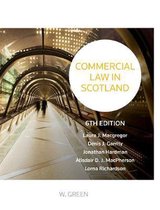Lecture 4 – Bankruptcy Law
The Concept of Bankruptcy
• Bankruptcy is a legal mechanism for allowing insolvent persons to put a limit on their
indebtedness so that they can start afresh in business, or indeed in life generally, while giving
some redress to creditors.
• In Scots law, bankruptcy is referred to as sequestration, i.e. the seizer of estate of the debtor,
either living or deceased, by the order of the court, for the benefits of creditors, when the
debtor is not able to pay its debt to creditors.
Especially done when the debtor is unable to pay his own loans. When the individual is not
able to pay their own loans, whether a bank or institution.
• Applied to persons, trusts, partnerships, associations, and clubs etc, not bodies incorporated
under the Companies Act 1985 or 2006, to which insolvency/liquidation law is applied.
Companies do not go through the process of bankruptcy.
• A bankrupt is a person who is or may be insolvent and cannot pay their creditors. A bankrupt
may not be a company director, not hold certain public offices such as a Member of
Parliament.
• The terms of many employment contracts state that bankruptcy is grounds for dismissal,
particularly if the employee is dealing with commercially sensitive measures.
Primary Legislation
Bankruptcy (Scotland) Act 2016 (came into force on 30th November 2016)
It consolidates and streamlines all the other Acts.
It is a good idea to be also aware of the Debt Arrangement and Attachment (Scotland) Act 2002.
Parties in sequestration
• Debtor, i.e. the bankrupt, not able to pay.
• Creditor: given the debt or loan and not able to get the repayments back.
• Trustee in sequestration: the person who looks after the debtor’s affairs in relation to
sequestration. They take all the assets of the debtor and look after them or sell them for the
creditors to be payed back.
• Trust Deed: is a voluntary but legal & binding arrangement between the debtor & the creditor
whereby the debtor transfers all or most of his assets in favour of a trustee for the benefit of
the creditors, providing certain degree of protection against the debt.
• Trust Estate: all the assets of the debtor under the administration of the trustee subject to
division between the creditors.
, • Accountant in Bankruptcy (AiB): An Executive Agency of the Scottish Government,
responsible for administering the process of personal bankruptcy and recording corporate
insolvencies in Scotland.
The AIB supervises the performance of interim trustees, trustees in sequestration and
commissioners. The AIB investigates complaints against interim trustees, trustees in
sequestration and commissioners.
The Accountant in Bankruptcy supervises the insolvency practitioners who act as trustees in
sequestration, or otherwise carry out bankruptcy work, and the Accountant in Bankruptcy
may be appointed trustee in any sequestration.
Who could be sequestrated?
• ordinary human beings; - Living Debtors
• the estate of a dead debtor; - deceased debtor
• trusts;
• partnerships and limited partnerships;
• bodies corporate and unincorporated (e.g. associations, clubs etc.)
Bear in mind - companies incorporated under the Companies Act 1985 or 2006 or limited liability
partnerships under the Limited Liability Partnership Act 2000 cannot be sequestrated.
The parties seeking sequestration
A. By “debtor application” (s.2(8) BSA):
• A debtor who is a resident in Scotland in the last year, and can pay the appropriate application
fee (between £90- £200) may apply to the Accountant in Bankruptcy for sequestration
provided the following are satisfied:
(a) the debtor’s debts are not less than £3,000, or 1,500 for Minimal Asset Process
(b) the debtor has obtained the advice of a money adviser, (they have all the facts given
to them)
(c) the debtor has given a statement of undertakings, (everything of what they have, this
being assessed by the common financial tool)
(d) there has been no previous award of sequestration against him within the previous
five years
And any of the following:
– the debtor is either apparently insolvent, must give evidence
or





